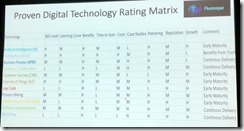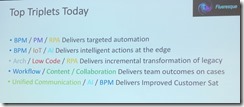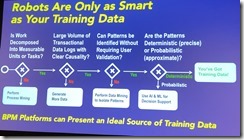Is the Citizen Developer Story a Fairytale? by Neil Miller of Kissflow
Given that Kissflow provides a low-code BPM platform, Neil’s answer is that citizen developers are not, in fact, unicorns: given the right tools, non-developers can build their own applications. Their platform allows a citizen developer to create a process-based application by defining a form, then a related process using a flowchart notation. Forms can link to internally-defined (or imported) data sources, and process steps can include links to webhooks to access external services. Simple but reasonably powerful capabilities, easy enough for non-technical analysts and business users to create and deploy single-form applications for their own use and to share with others. He also showed us the new version that is being released next month with a number of new features and tools, including more powerful integration capabilities that are still well within the reach of citizen developers. The new version also includes completely new functionality for unstructured collaborative scenarios, which can include conversation streams and tasks, plus Kanban boards for managing projects and tasks. There’s still a lot missing for this to handle any type of core processes (e.g., versioning, testing) but good for administrative, situational and collaboration processes.
Insightful Process Analysis, by Jude Chagas-Pereira of Wizly, Frank Kowalkowski of Knowledge Consultants, Inc., and Gil Laware of Information by Design
Wizly provides a suite of analysis tools including process analytics, using process mining and other techniques in demo focused on improving an airline’s call center performance. Jude showed how they can compare process history data against a pre-defined model for conformance checking, and a broad range of analysis techniques to discover correlations between activities and customer satisfaction. They can also generate a “DNA analysis” and other data visualizations, then filter and re-slice the data to hone in on the problems. The main tabular interface is similar to Excel-type filtering and pivot charts, so understandable to most business data analysts, with visualizations and extra analytical tools to drive out root causes. This set of process analytics is just part of their suite: they can apply the same tools to other areas such as master data management. We had a previous look at this last year under the name Aftespyre: Frank pointed out that he and Gil develop the intellectual property of the analytical models, while Jude’s company does the tool implementation.
Improving the Execution of Work with an AI Driven Automation Platform, by Kramer Reeves, Michael Lim and Jeff Goodhue of IBM
Jeff took us through a demo of their Business Automation Workflow Case Builder, which is a citizen developer tool for creating case and content-centric applications that can include processes, decisions and services created by technical developers layered on a simpler milestone-based flow. Checklists are built in as a task management and assignment, allowing a business user to create an ad hoc checklist and assign tasks to other users at any point in the case. We also saw the process task interface with an attended RPA bot invoked by the user as a helper to open the task, extract related data from a legacy interface, then update and dispatch the task . Alongside the process task interface, he showed us using a conversational interface to their Watson AI to ask what type of accounts that the client has, and what documents that they have for the client. We also saw the integration of AI into a dashboard to make decision recommendations based on historical data. He finished with their new Business Automation Studio low-code design environment, where we saw how the citizen developer can add integrations that were created by technical developers, and create new pages in a page flow application. It’s taken a long time for IBM to bring together their entire automation platform based on a number of past acquisitions, but now they appear to have a fairly seamless integration between case/content and process (BPM) applications, with low code and Watson sprinkled in for good measure. They’re also trying to move away from their monolithic pricing models to a microservices pricing model, even though their platforms are pretty monolithic in structure: Mike made the point that customers only pay for what they use.
That’s it for day 1 of bpmNEXT 2019; tomorrow morning I’ll be giving a keynote before we start back into demo rounds.



